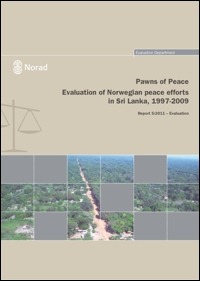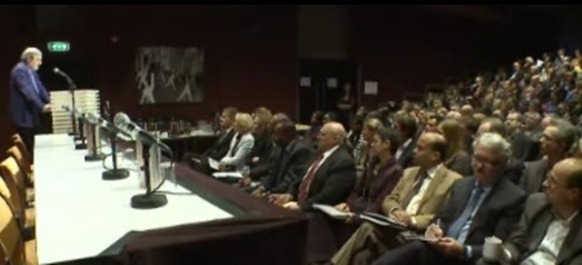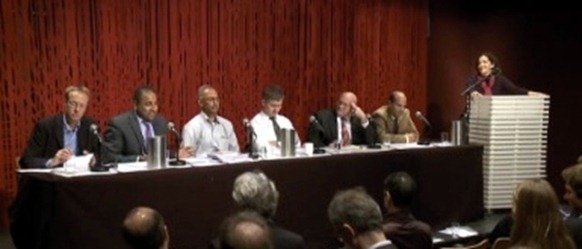 The Norway report on the failed peace in Sri Lanka, concluding that Asian powers in pursuance of military solution were a reason for the failure, cautions that this model of ‘conflict resolution’ will challenge future Norwegian-style mediations. India’s role in the genocidal model of conflict resolution is not adequately discussed in the report, yet bits and pieces in the report along with what transpired in the panel discussion in Oslo on Friday, place India as decisively responsible for the ‘Asian model’ that ended the war in genocide. Meanwhile, citing the upsurge of Sinhala nationalism as a result of the international peace process, the report advises appeasement by leaving the fate of Eezham Tamils to ‘domestic solutions’. But an upsurge of Tamil nationalism resulting from the genocide, snowballing in either side of the Palk Bay, is yet to make impact with the IC.
The Norway report on the failed peace in Sri Lanka, concluding that Asian powers in pursuance of military solution were a reason for the failure, cautions that this model of ‘conflict resolution’ will challenge future Norwegian-style mediations. India’s role in the genocidal model of conflict resolution is not adequately discussed in the report, yet bits and pieces in the report along with what transpired in the panel discussion in Oslo on Friday, place India as decisively responsible for the ‘Asian model’ that ended the war in genocide. Meanwhile, citing the upsurge of Sinhala nationalism as a result of the international peace process, the report advises appeasement by leaving the fate of Eezham Tamils to ‘domestic solutions’. But an upsurge of Tamil nationalism resulting from the genocide, snowballing in either side of the Palk Bay, is yet to make impact with the IC.
 The geopolitical imbalance affecting Eezham Tamils continue even in post-war politics, as in the assessment of the international community Tamil solidarity or the possibility of an upsurge of Tamil nationalism is not a significant equation to influence the powers as the Sinhala nationalism influences them.
The geopolitical imbalance affecting Eezham Tamils continue even in post-war politics, as in the assessment of the international community Tamil solidarity or the possibility of an upsurge of Tamil nationalism is not a significant equation to influence the powers as the Sinhala nationalism influences them.
Perhaps the IC is confident that New Delhi or Tamil Nadu politicians could contain any upsurge of nationalism in Tamil Nadu materialising the cause of Eezham Tamils.
The Norway report indirectly or naively accepts that ‘peace’ within the framework of united Sri Lanka failed, either by international peace mediation or by military intervention. In both ways – military intervention by India and mediation by IC-backed Norway – all the attempts hitherto were aiming at preserving the unity and integrity of State in the island.
Obviously, the failure in achieving peace within united Sri Lanka has narrowed down the choice now. There need to be no mincing of words: either secession or genocide of the nation of Eezham Tamils sooner or later.
Norway, India and the IC, know this reality, but refrain from accepting it and naively opt for the latter solution in the name of ‘domestic’ solution or in other words, Rajapaksa’s ‘home-made’ solution.
The Norway report laments at the ‘military solution’, acknowledges the upsurge in Sinhala nationalism and speaks about “old tricks in the Sri Lankan book.”
At the Oslo panel discussion, the team leader of the report, Gunnar M. Sørbø, who as a social anthropology academic rising above the narrow perspectives of politicians, diplomats, and intelligence personnel, reminded the issue of life and death in such peace processes and argued that Norway had the option of quitting in order to signal the world on the realities of the war in the island.
The reality of ‘military solution’ in the context of Sri Lanka is nothing but genocide, as the military is a Sinhala military.
But none of the players, including the Norway report writers, are prepared to spell it out, as it would justify the independence of Eezham Tamils.
There is no point in any of them talking about war crimes because worse crimes are committed by not accepting people’s realities.
They all now talk about ‘domestic’ solutions because they think it is conducive for the competing powers in the island to maintain status quo.
Genocidal Colombo will carefully maintain the status quo to complete its agenda.
The biggest loser is India, even though it cons about its ‘exclusive rights’ in resolving the crisis in the island. But the realities are different. So, it does nothing, sits on any international solution and barters Eezham Tamil interests for its leverage in the island as that is the only thing it could offer to maintain its status quo with the other powers in the island.
* * *
India’s stand on political solution:
All hands now point to India for adamantly refusing to see secession as an option, for playing the decisive role in ending the war in genocide, for not acknowledging the war crimes and for sitting on international investigations, justice and solutions.
India never accepted the struggle for Tamil Eelam, as they never approved of the LTTE, the Norway report team leader said in the panel discussion Friday.

Gunnar Sørbø addressing the audience
The report comes out with further evidence that the paranoia of India didn’t stop just at refusing the independence of Eezham Tamils. India worked against even federalism and later against the ISGA proposals, which according to the Norway report was a significant alternative for Tamil Eelam coming from the LTTE.
“India had unsuccessfully mounted all the leverage it had to enforce a political solution short of federalism,” the report says about IPKF militarily trying a solution within united Sri Lanka, without even conceding federal status.
“ISGA was not acceptable for the Muslim and Sinhala minorities, for the government and for India, all of whom are concerned that the proposed referendum after the interim period could still lead to some form of secession.” (p 47)
“India supported Norway because they thought it would not work anyway. India had very clear ideas about the acceptable parameters for a settlement; it would not countenance anything that went beyond the 13th amendment in terms of devolution of power to the north-east. Also, the ‘LTTE could not be part of the solution.” (p 73)
India now promotes a nondescript domestic solution, while silently abetting the structural and demographic genocide of Eezham Tamils to take place intensively.
India has never come out with any substantial ideological or practical reasons why the Eezham Tamils long suffering from genocide should not get independence.
It can never be the wish of the peoples of India that Eezham Tamils should not get independence. It cannot be the wish of the popularly elected representatives of the peoples either. From what quarters the democracy of India is hijacked is for the peoples of India to identify.
Indian people continue to tolerate Foreign Secretaries and National security Advisors talking like politicians. The Indian Foreign Secretary Ranjan Mathai, on a bilateral issue with Bangladesh said that India would not go against the wishes of its states (West Bengal in this case). But he proclaimed the opposite in protecting Rajapaksa in the CHOGM, despite a unanimous resolution in the Tamil Nadu State Assembly urging war crimes investigations and sanctions against Sri Lanka.
The Norway report aptly observes: “India’s accelerated integration into the global economy transformed the main electoral priorities, with ‘bread and butter issues’ trumping solidarity with Tamils living across the Palk Strait.”
* * *
India and the conduct of the war as seen by the Norway report:
With Congress coming to power in 2004, India offers Radar services to Colombo. (p54)
“More importantly, Indian opposition to the LTTE starts to translate into firmer backing for the Sri Lankan government.” (p58)
“Sri Lanka also secured an air force servicing agreement with Pakistan, improved its electronic and other surveillance with inputs from Indian and US intelligence.” (p94)
“The interception of LTTE ‘merchant’ ships with reported Indian support (and possibly US intelligence.” (p95)
“India appeared to have given the government tacit (and to some extent active) support in its military campaign and as explored further below, other regional powers (mainly China) stepped in to back the government.” (p74)
Contrary to what India was projecting to its people about China’s involvement, the Norway report testifies that it was India that encouraged Sri Lanka to bring in China.
“Delhi maintains it will not provide offensive military assets – due to the political sensitivity of Indian weapons being used against Tamils – but off the record, it does not object to Sri Lanka purchasing weaponry elsewhere.” (p59)
“We did not want Indian bullets used against Tamils,” a senior Indian diplomat explained. But it did provide intelligence and radar surveillance, and it did not oppose Sri Lanka’s military purchases in China, “so as to not alienate Rajapaksa and to avoid China and Pakistan from getting a hold,” an Indian observer said, the report cited.
“As the military offensive intensifies, it becomes increasingly clear that India will not apply pressure on the Sri Lankan government to call off the offensive. Behind the scenes, India is ‘not hesitant to support the government’s offensive against the LTTE,’ but realizes it needs to ‘manage the political fallout,’ according to a senior Indian diplomat reflecting on this period. It is considered a ‘no-brainer’ that India should ‘support the government in this offensive. In public, however, the Indian government refrains from voicing these views,” (p63)
“India meanwhile walked a fine line between showing concern for the plight of the Tamils stuck in the war zone while supporting the defeat of the LTTE and preserving its ties with the Sri Lankan government. Most observers agree that India’s most important influence on the end of the war lay not in the things it did and said, but in the things it did not do and say. ‘The war was led by Indian silence.” (p78)
“It is also doubtful India has any interest in the LTTE surviving the end of the war.” (p67)
“The Indian External Affairs establishment in fact seems to consider its handling of the end of Sri Lanka’s war a relative success.” (p79)
* * *
Norway report talks on India’s handling of the peace process:
“It identifies India and the US as the main players and gets their concurrence. In meetings in Delhi with the Indian Foreign Secretary, the National Security Advisor and the intelligence agency (RAW), it becomes clear that India will keep an arm’s length approach and will not take an active role in the process [in 2001 during BJP government].” (p33)
“To keep the discussion moving, help is sought from Satish Nambiar, a retired Indian general, who drafts a revised plan, suggesting a phased dismantling of High Security Zones matched by simultaneous dismantling of LTTE operational capacities.” (pp 41-42)
“India’s response to Norway’s role was less committal and less optimistic. India did not object since they saw Norway as non-threatening and gave them (lukewarm) support in the absence of any obvious alternatives. As one Indian informant commented: ‘the attitude was: try it and we’ll see what happens, [but] the Indians never factored Norway as a serious presence. They were respectful, but sceptical of what they could actually do.” (p73)
“The downside, according to one Indian diplomat, was ‘that Norway gave the LTTE some legitimacy which we found very uncomfortable.” (p74)
“India did not oppose Japanese involvement, but there was little enthusiasm for an overly political Japanese role. In the words of an Indian diplomat, Akashi was pretty much irrelevant.”
“The Sea Tigers and maritime shipments are vital for the LTTE, but it is difficult for the government to accept a compromise on the sea. Moreover, the navy, Kumaratunga and India are very sceptical about this issue, so the clause on this [in the CFA] is deliberately kept woolly.”
India opposed a stronger SLMM.
The report also hints that the split of Karuna found Indian support. The report says that for the first time the SL Army played an autonomous role in dealing with Karuna, against the wishes of the then President Kumaratunga, and Karuna was subsequently brought to India (p50). [Karuna found the patronage of The Hindu in Chennai]. Norway tried through UNP and PA to tell India not to recognize Karuna (p51).
“With the peace talks deadlocked, however, it becomes clear international support for the process is increasingly fragmented. India refuses to take a more overt role. (p49)
Rajapaksa rejected Norway and suggested UN, India and another regional power to facilitate peace. (p56)
“The Norwegians continue to solicit a more active Indian role in support of the talks in 2007, but Delhi continues to decline the suggestion.”
The report records the following on the rift between the approaches of Norway’s peace process and the aims of India:
“The then Norwegian ambassador in Colombo, Tore Hattrem described India as suffering from a ‘Burma syndrome’ in its Sri Lanka policy, meaning that it would not place a focus on human rights and democracy issues (as arguably had been the case in Burma in the 1990s) for fear of pushing the country into a closer relationship with China. India continued to express support for Norway’s efforts in Sri Lanka, but with the return of the UPA and the resumption of war, Delhi’s support for the Sri Lankan government (whether open or tacit) amounted to pursuing peace through the military defeat of the LTTE (see also International Crisis Group, 2011). The contradictions between this and Norway’s approach became ever wider.” (p76)
* * *
Erik Solheim paints a different picture of India’s role:
The following are excerpts from the speech as well as question and answer session of Erik Solheim at the panel discussion on Norway’s report, Friday:
“We started the peace process on the part of Norway with the belief that this could be resolved in a few months time. The Indians told us please be patient. If you cannot be patient, go away, I mean, get out of South Asia, you will only complicate matters. This will take a decade at the minimum. So, we learnt to be patient and you need to be patient with a peace process.”
“India, throughout had a veto power over the peace process. Because the Tigers did not have access to India, Milinda and myself shuttled to Delhi. I don’t know how many times I have been at the Indian airport of New Delhi, meeting Indian intelligence and others and there was no major step in the peace process whatsoever was taken without informing India. Sometimes they gave tacit accept even if they may have disagreed. But, India was throughout informed. And the reason for that was very simple.”
“From Day 1, we took the view that India is by far the most important foreign influence in Sri Lanka. The United States is important. But, it is second to India. And even more so, for India, Sri Lanka is a core interest. For the United States, it is periphery interest. And the United States will never ever risk relationship with India for Sri Lanka. So, if India is on board, ultimately the United States will basically follow. Most important and even into the details, for instance, what nations should be acceptable in the Sri Lanka Monitoring Mission – they [the Indians] gave us a list of nations that they would accept and we picked from that [smiling].”

Panel discussion
“Then, may be on the views on different roles of India, but there can be no different views on the fact that India was consulted throughout the peace process. Milinda can confirm it. I can confirm it. Every other actor can confirm it. India was much more into the peace process than most people tend to believe. There were secret meetings between the India and the LTTE. I participated in these meetings. I will not disclose who were they and where did that happen, but they did happen. There was lot more contacts. India, at every stage was consulted. They were kept informed on the smallest details and throughout they were supportive to the peace process. And, only in the final stage of 2008 onwards, top Indian officials saw there could be a military answer to the conflict. Prior to that they all said no –all that the foreign minister and all the heads of the intelligence apparatus and heads of the Foreign Service – who were the key individuals. So, the role of India was throughout.”
“I was very – I have to say Very Close – to Indian Intelligence. I met them enormous amounts of time throughout this process. Never, ever did any Indian official hint that a military victory was possible until mid 2008. Then they started, I mean I observed the change in Mr. Narayan and others, gradually shifting to the position that maybe – still may be that the government can wipe out the Tigers, militarily. Before that, no one thought it was possible. United States thought it was impossible; India thought it was impossible; Colombo thought it was impossible. So again, complete change from what we all based the peace process on, until that point.”
[Mr Solheim on Friday had to defend him against the observation of the report and the remarks of the report team leader that Norway should have quitted the peace process at an earlier opportunity in order to signal the world about the realities of the peace process turning into war. The thrust of Solheim’s speech largely blamed the LTTE, subtly shielded and defended the other players from war crime indictments and saw the end of the war not as a culmination of an intentional process but as a historical accident. “What happened was not necessarily what had to happen,” he said.]
* * *
BJP and Congress governments:
The report records the difference in the outlook between the BJP and Congress governments during peace and war in the island.
India under BJP was not much interested in involving in Sri Lanka, the report revelations showed.
According to Mr. Solheim, LTTE and India secretly met at the inception of the peace process [in BJP times]. Solheim declined to say where the meeting took place and who participated.
Since Congress coming to power, India militarily and diplomatically helped Colombo, and the Indian agenda of military solution differed from the approaches of the Norwegian peace process is the observation of the report that places much of the responsibility of the ‘Asian model of conflict resolution’ with the Congress regime of India.
The report also touches on the point that there were expectations of a different end of the war, pinning hopes on a BJP victory in May 2009.
“Indian Home Minister Chidambaram contacts Prabhakaran and suggests the LTTE agrees to a pre-drafted statement that they will lay down their weapons,” the report says, but without giving citations the report continues, “The document leaks to Vaiko, a radical but marginal Eelamist politician in Tamil Nadu, who rejects it as a Congress trick and assures the LTTE that BJP will win the ongoing Indian elections and come to the Tigers’ rescue.” (pp 67-68)
* * *
Rajiv Gandhi assassination factor:
The report also establishes a connection between the Rajiv assassination and the military solution to the conflict:
“However, crushing the LTTE has become the overriding concern after the disasters of the Indo-Lankan Accord in 1987 and the subsequent LTTE assassination of former Prime Minister Rajiv Gandhi in May 1991. The return to power of the Indian National Congress (now headed by his widow Sonia Gandhi) in 2004 and declining influence of Sri Lanka on Tamil Nadu politics (see chapter 7) mean that there are fewer inhibitions on a military solution to the conflict. India thus continues to advocate for the accommodation of Tamil aspirations in Sri Lanka, but does not apply any pressure against the Rajapaksa government in relation to the military option.” (p59)
Mr. Erik Solheim also extensively touched on the point in his speech and in answering questions Friday.
“Of course, the killing of Rajiv Gandhi was an enormous blunder. If you want to receive the support from the United States, would you kill an American president? I mean, who would even contemplate that? India was the main source of support for the Tamil Tigers, why then kill Rajiv Gandhi, an outstanding Indian prime minister, Solheim asked.
During the question and answer session, Mr. Solheim was asked by Mr. Pirabukkannan, a native of Tamil Nadu living in Norway that why was he always referring to the killings done by only one party while there were several Tamil leaders who were killed by the SL State.
Even on that occasion, Mr. Solheim brought out the case of Rajiv Gandhi and said: “But, for a non-state actor attacking and killing the [former] Prime Minister of India – Frankly, that is very rare. It is hard to think of any terrorist group attacking the president of America, or the president of China and the Prime Minister of India. It is immoral and is also enormously foolish. India was the main source of strength of the Tamil Tigers, why do they then kill the [former] prime minister of that land,” Solheim asked.
Many Tamil Nadu leaders who were negotiating with the New Delhi Establishment on stopping the war in the island also testify that there was a tendency in New Delhi to link Rajiv assassination with the military solution.
If what the report says and Solheim implies was true, then India is answerable to a serious war crime in contemporary human civilisation.
It is hard to think that the largest democracy in the world has decided to commit the genocide of a nation for the assassination of a former prime minister, whose case details are still murky and who was also not innocent of the command responsibility to the war crimes committed by the IPKF against Eezham Tamil civilians.
Why the continued injustice to the nation of Eezham Tamils if the assassination was the reason for the military solution, as some try to reduce and camouflage the larger issues?
While concluding his remarks at the panel discussion Friday, Gunnar M. Sørbø, the leader of the team that wrote the report said: “On the role of India, there are many other points of view than is reflected in the panel here – I must say. I just ask you to read the report. We have been in Delhi and Chennai and there were many other points of view that were simply reflective.”
(For updates you can share with your friends, follow TNN on Facebook and Twitter )
